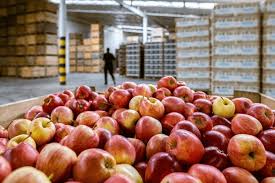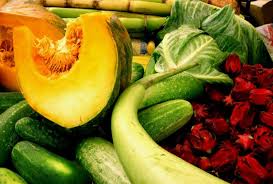Most often, agricultural produce is not sold immediately after production or purchase. Therefore, firms require storage facilities. This article introduces warehousing and marketing policies within the agricultural sector.
1. Warehousing
Rarely are products sold as soon as they are produced; as such, firms require storage facilities. Two types of warehouses meet this need: storage warehouses, which hold goods for a much longer period of time, and distribution warehouses, which serve as way stations for goods as they pass from one location to another. Warehouses can be wholly owned by firms, or space can be rented as needed.
Although companies have more control over wholly owned facilities, such warehouses can tie up capital and a firm’s resources. Common operations in warehouses usually require the inspection of goods, trading of inventories, repackaging of goods, and invoicing. Agricultural produce may be treated with chemicals or other traditional methods to extend their storage life.
2. Marketing Policies
Marketing policies are the conditions of sale or terms of sales, which the seller usually circulates to their customers. Marketing policies, therefore, vary from one company to another and depend on the nature of goods and services offered.
Read Also: Recommended Volume of Water for Fish Farming on a Concrete Pond
Relationship Between Warehousing and Marketing Policies

It is necessary for manufacturers to place a high premium on storage to guard against the consequences of market disruptions. These disruptions can be engendered by factors such as industrial action by labor or sabotage, as is the case with oil installations in the Niger Delta area.
Market participants have continued to seek more efficient financial and operational methods to manage risk in an environment of diminishing profit margins. Storage operators would certainly provide relief to producers and marketing agents, as they protect against transportation and storage risks.
The development of an efficient storage system will require the government to make enabling laws that allow parties to enter into financial contracts with less bureaucracy.
Different Modes of Distributing Agricultural Products in Nigeria
The mode of distribution refers to the physical movement of agricultural produce from one location to another. There are four distinct modes of distributing agricultural produce in Nigeria: rail, road, water, and air.
1. Railways: The railway system was established primarily to evacuate agricultural and mineral products for export. However, the railways have not made any appreciable impact on internal trade. The main reasons for the decline of railway performance include poor management, the rise of road transport, and the decline in traditional railway commodities like groundnuts and tin.
2. Road: Road transport has been the backbone of commercial freight movement, with fleets of trailers and tankers hauling goods across the country daily. About 80 percent of the movement of goods is done by road.
However, road transport is plagued by problems like non-availability of spare parts, poorly maintained roads, and the risk of armed attacks at night, though these issues have not reduced its growing importance.
3. Water: The Niger and Benue Rivers and their tributaries form the major inland waterways for goods and people. Low water levels during insufficient rainfall and competition from road transport tend to diminish the importance of water transport in Nigeria. For water transport to regain its importance, dredging of waterways is required.
4. Air: There are only four viable international airports in Nigeria: Lagos, Abuja, Port Harcourt, and Kano. Air cargo lifting is still relatively small. However, with greater industrialization and the globalization of trade, the importance of air transport is expected to increase.
Read Also: Concrete Pond Management: Steps to take before introducing the Fish in the Water
5. Impact of Freight Charges on Agricultural Produce

The effect of freight charges on agricultural produce largely depends on the mode of transport used. The following factors are to be considered:
1. Speed: The time needed to move produce from the point of production to the point of consumption.
2. Frequency of Service: The number of vehicles moving between production and consumption points per period; lower frequency means higher freight charges.
3. Dependability: The ability to meet required schedules.
4. Operational Capability: The ability to handle all kinds of freight, from large to fragile or perishable crops.
5. Cost: The average cost per ton and kilometer, which varies depending on the transport mode and the agricultural product being transported.
Costs of Physical Distribution
Physical distribution, or logistics, concerns the efficient movement of agricultural products from farmers (production) to consumers or users. Several associated activities are grouped into four main categories known as “physical distribution activity centers”: transportation, inventory, warehousing, and communications.
1. Transportation Costing: Three basic costs are involved in moving produce: line haul costs (freight charges for movement), terminal costs (handling freight at terminals), and pick-up and delivery costs (within terminal areas).
2. Inventory Carrying Cost: Inventory costs for farmers can range between 25% and 30% of the value of the inventory. These costs include capital tied up as inventory, expenses for special storage equipment, insurance, and tax.
3. Warehousing Costs: Both fixed costs (utilities and salaries) and variable costs (space and labor) apply to maintaining a warehouse. Other costs include unit loading, packaging, and handling.
4. Communication Costs: Communication is essential between farmers, middlemen, and consumers. Mail is the cheapest communication method, but GSM phones and email have become prevalent for faster communication.
Do you have any questions, suggestions, or contributions? If so, please feel free to use the comment box below to share your thoughts. We also encourage you to kindly share this information with others who might benefit from it. Since we can’t reach everyone at once, we truly appreciate your help in spreading the word. Thank you so much for your support and for sharing!
Read Also: Adaptive Means of Animals Coping with the Environment






